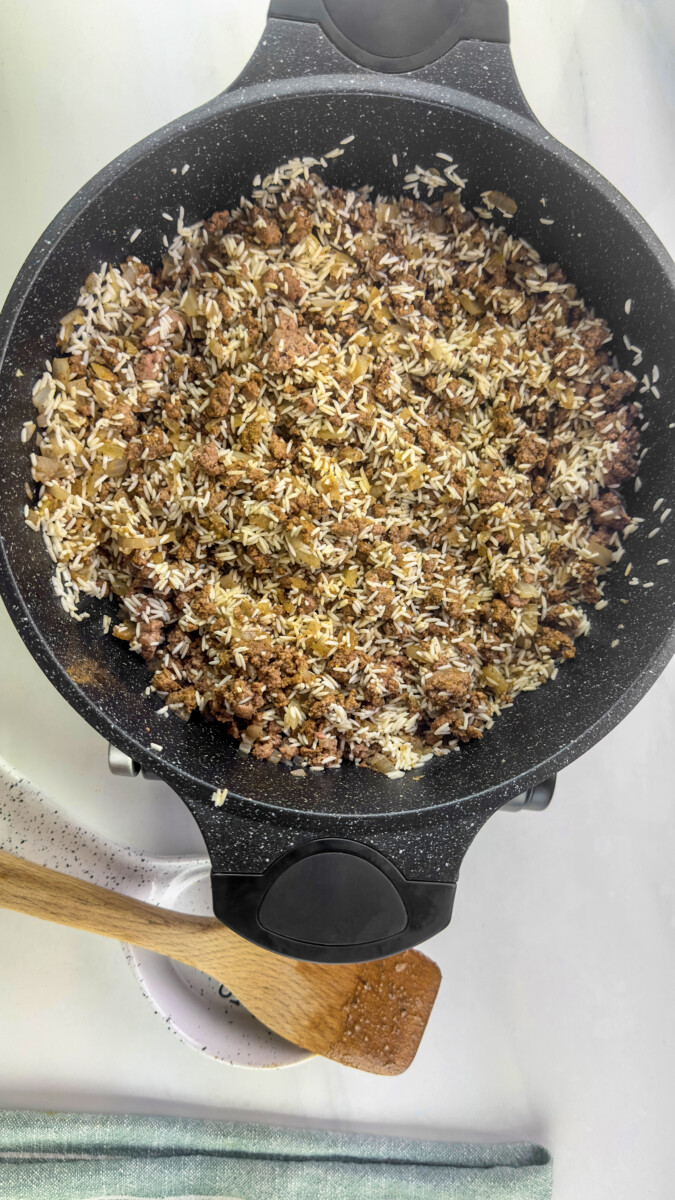This dish has become a cherished family tradition that we eagerly look forward to, and I’m thrilled to share it with you. The perfectly cooked rice, savory ground lamb, aromatic spices, and toasted nuts create a flavorful and comforting meal that’s sure to delight.
Lebanese Hashweh Rice, a beloved dish across the Middle East, is cherished in many families, including mine. Growing up, my mother would prepare this special Lebanese rice recipe for festive occasions, serving it on a large platter topped with chicken or lamb and garnished with toasted pine nuts and almonds. Even now, I follow her traditional method, and every bite takes me back to those warm, joyful childhood memories.
This delicious Lebanese rice recipe perfectly accompanies a simple Arabic salad or yogurt salad or is served alongside other dishes like roasted chicken or lamb chops and roasted vegetables. Its unique blend of spices and textures makes it an exceptional and flavorful addition to any meal. Due to the delicious flavor and nostalgia this dish brings me, it has become one of my favorite Hashweh recipes. Read more about this authentic Hashweh recipe below. I sincerely hope you enjoy it!
What is Lebanese Hashweh Rice?
Lebanese Hashweh Rice is a cherished Middle Eastern dish deeply rooted in the tradition of stuffing. “Hashweh” translates to “stuffing” and typically involves mixing ground lamb with separately cooked rice seasoned with warm, aromatic spices like cinnamon. While the exact spice blend may vary by region, some versions also include sweet peas or other vegetables for added texture and flavor.
Traditionally, this savory rice mixture is used as a stuffing for chicken or lamb, much like in my Cornish hen recipe. Yet, it’s equally delightful as a stand-alone side dish, where the spiced rice shines on its own. Each bite celebrates rich flavors and aromatic spices, making it an authentic Middle Eastern classic.
Ingredients Need to Make for Lebanese Rice:
- Long-Grain White Rice: Long-grain white rice is the ideal choice, as it cooks up fluffy and separate, providing the perfect canvas for flavorful spices and seasonings. It’s important to note that one cup of uncooked long-grain white rice typically yields about three cups of cooked rice, making it an excellent option for serving a gathering of family and friends.
- Olive Oil and Ghee: The combination of olive oil and ghee adds a rich, buttery undertone and a silky texture to the rice, enhancing its overall taste.
- Chopped Onion: Onions offer a sweet and savory base, infusing the rice with a delightful depth of flavor.
- Ground Lamb or Beef (or a Combination): The choice of protein brings a hearty and meaty essence, creating a satisfying and wholesome dish.
- Seven Middle Eastern Spices (Baharat): Baharat, a blend of aromatic spices, including cinnamon, nutmeg, and more, imparts a warm and earthy flavor profile to the rice.
- Cinnamon and Nutmeg: These spices contribute to the dish’s warm and slightly sweet notes, enhancing its Middle Eastern character.
- Hewaja (Optional): While optional, hewaja adds a unique depth of flavor, bringing your dish closer to the cherished specialty of many Lebanese kitchens.
- Salt balances the flavors, ensuring a harmonious taste in every bite.
- Chicken Broth or Water: Whether you opt for chicken broth or water, this liquid element infuses the rice with moisture and savory goodness.
- Toasted Pine Nuts and Almonds: The nutty crunch of toasted pine nuts and almonds adds a delightful contrast in texture and a nutty richness to the dish.
- Chopped Parsley: Fresh parsley brightens the dish with a burst of freshness, enhancing its overall presentation and taste.
What is the Ratio of Rice to Meat?
The rice-to-meat ratio in hashweh rice often depends on personal preference. Some prefer a meatier dish, while others enjoy a more rice-forward balance. I like to use 1 ½ cups of rice for every pound of beef, as this ratio perfectly balances flavor and texture. This typically serves about six people, but you can easily adjust the measurements to fit your needs.
While I enjoy using a mix of ground lamb and beef in my hashweh rice, you can experiment with other meats to find the flavor profile that delights your taste buds. Whether you prefer lamb, beef, or a combination, this dish is versatile and adaptable to your preferences.
Variations of Hashweh Lebanese Rice
While traditional Lebanese Hashweh rice features ground meat and aromatic spices, there are countless ways to customize this dish to suit your preferences. For a vegan-friendly version, skip the meat and add garbanzo beans, chopped tomatoes, and fresh herbs for a flavorful twist.
You can also enhance the dish by incorporating vegetables like carrots and peas alongside the meat. For added depth, try experimenting with different types of mushrooms or fresh herbs such as cilantro. One of the greatest features of Hashweh rice is its versatility—tailor it to your taste and create a version that’s uniquely yours. With a bit of creativity, this classic dish can take on countless delicious variations to delight your palate.
Step-by-Step Instructions

Start by washing the rice thoroughly and soaking it in water for 15 minutes. Strain the rice and set it aside. In a medium-sized pot over medium heat, combine 1 tablespoon of olive oil and 1 tablespoon of ghee. Once the ghee has melted, add the chopped onion and sauté until translucent, about 5 minutes.

Add the ground meat to the pot, breaking it apart with a wooden spoon. Stir in the spices and mix thoroughly. Cook for about 5 minutes, allowing the meat to brown slightly. Next, add the rice to the pot and mix well, ensuring it is fully incorporated with the meat. Let the rice absorb the flavorful juices released by the meat.

Heat 1 tablespoon of olive oil over medium heat in a small skillet. Add the pine nuts and almonds, toasting them until golden and caramelized. Be sure to stir frequently to prevent burning. Once toasted, set them aside.

Pour the chicken broth or water into the pot and bring to a boil—season with salt to taste. Once the liquid has slightly reduced, lower the heat to a simmer and cover the pot with a tight-fitting lid. Allow the rice to cook for 20 minutes, absorbing all the flavorful broth.

Turn off the heat and let the rice sit for 10 minutes with the lid on. This resting time allows the rice to finish steaming and enhances its texture. After 10 minutes, add the toasted nuts to the pot, mixing some into the rice. Sprinkle the remaining nuts on top, along with freshly chopped parsley.
Serve and enjoy your flavorful Lebanese Hashweh Rice!
Ingredients:
| 1 1/2 cup long-grain white rice | |
| 2 tablespoons olive oil, divided | |
| 1 tablespoon Ghee or unsalted butter | |
| 1 cup chopped onion | |
| 1 lb ground lamb or beef | |
| 1/2 tablespoon of seven spices ( Middle Eastern) | |
| 1/2 teaspoon cinnamon | |
| 1/8 teaspoon freshly ground nutmeg ( a pinch) | |
| 1 teaspoon hewajah (optional) | |
| 1 teaspoon salt | |
| 2 1/4 cups chicken broth or water | |
| 1/4 cup toasted pine nuts | |
| 1/4 cup almonds | |
| 1/4 cup chopped parsley |
Preparation
Recipe Tips & Suggestions
The best storage and reheating methods for hashweh rice:
Nutrition Information
The information shown is an estimate provided by an online nutrition calculator. It should should not be considered a substitute for a professional nutritionist's advice.
See our full nutrition disclosure here.
-
Jamee Roberts
I make Hashweh every Thanksgiving for the past 40 plus years. It was my spouse’s Lebanese family’s tradition. The recipe that I learned from his grandmother used walnuts instead of pine nuts or almonds. This may have been due limitations on ingredients in the MidWest region where they lived.








Have you made this Lebanese Hashweh Rice? What kind of spices did you use?? I love to hear from you; please leave a comment below.